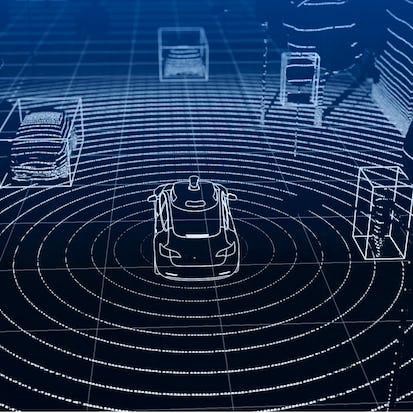- Level Expert
- المدة 31 ساعات hours
- الطبع بواسطة University of Toronto
-
Offered by

عن
Welcome to Visual Perception for Self-Driving Cars, the third course in University of Toronto's Self-Driving Cars Specialization. This course will introduce you to the main perception tasks in autonomous driving, static and dynamic object detection, and will survey common computer vision methods for robotic perception. By the end of this course, you will be able to work with the pinhole camera model, perform intrinsic and extrinsic camera calibration, detect, describe and match image features and design your own convolutional neural networks. You'll apply these methods to visual odometry, object detection and tracking, and semantic segmentation for drivable surface estimation. These techniques represent the main building blocks of the perception system for self-driving cars. For the final project in this course, you will develop algorithms that identify bounding boxes for objects in the scene, and define the boundaries of the drivable surface. You'll work with synthetic and real image data, and evaluate your performance on a realistic dataset. This is an advanced course, intended for learners with a background in computer vision and deep learning. To succeed in this course, you should have programming experience in Python 3.0, and familiarity with Linear Algebra (matrices, vectors, matrix multiplication, rank, Eigenvalues and vectors and inverses).الوحدات
Course Introduction
1
Discussions
- Get to Know Your Classmates
2
Videos
- Welcome to the Self-Driving Cars Specialization!
- Welcome to the course
4
Readings
- Course Prerequisites
- How to Use Discussion Forums
- How to Use Supplementary Readings in This Course
- Recommended Textbooks
Meet the Instructors
2
Videos
- Meet the Instructor, Steven Waslander
- Meet the Instructor, Jonathan Kelly
The Camera Sensor
2
Videos
- Lesson 1 Part 1: The Camera Sensor
- Lesson 1 Part 2: Camera Projective Geometry
1
Readings
- Supplementary Reading: The Camera Sensor
Camera Calibration
1
Videos
- Lesson 2: Camera Calibration
1
Readings
- Supplementary Reading: Camera Calibration
Visual Depth Perception
2
Videos
- Lesson 3 Part 1: Visual Depth Perception - Stereopsis
- Lesson 3 Part 2: Visual Depth Perception - Computing the Disparity
1
Readings
- Supplementary Reading: Visual Depth Perception
Image Filtering
1
Videos
- Lesson 4: Image Filtering
1
Readings
- Supplementary Reading: Image Filtering
Weekly Assignment: Applying Stereo Depth to a Driving Scenario
- (Submission) Applying Stereo Depth to a Driving Scenario
1
Assignment
- Module 1 Graded Quiz
2
Labs
- Practice Assignment: Applying Stereo Depth to a Driving Scenario
- (Solution) Applying Stereo Depth to a Driving Scenario
Image Features and Feature Detectors
4
Videos
- Lesson 1: Introduction to Image features and Feature Detectors
- Lesson 2: Feature Descriptors
- Lesson 3 Part 1: Feature Matching
- Lesson 3 Part 2: Feature Matching: Handling Ambiguity in Matching
3
Readings
- Supplementary Reading: Feature Detectors and Descriptors
- Supplementary Reading: Feature Matching
- Supplementary Reading: Feature Matching
Outlier Rejection & Visual Odometry
2
Videos
- Lesson 4: Outlier Rejection
- Lesson 5: Visual Odometry
2
Readings
- Supplementary Reading: Outlier Rejection
- Supplementary Reading: Visual Odometry
Weekly Assignment: Visual Odometry for Localization in Autonomous Driving
- Visual Odometry for Localization in Autonomous Driving
1
Labs
- Visual Odometry for Localization in Autonomous Driving
Neural Networks
3
Videos
- Lesson 1: Feed Forward Neural Networks
- Lesson 2: Output Layers and Loss Functions
- Lesson 3: Neural Network Training with Gradient Descent
3
Readings
- Supplementary Reading: Feed-Forward Neural Networks
- Supplementary Reading: Output Layers and Loss Functions
- Supplementary Reading: Neural Network Training with Gradient Descent
Neural Networks Continued
3
Videos
- Lesson 4: Data Splits and Neural Network Performance Evaluation
- Lesson 5: Neural Network Regularization
- Lesson 6: Convolutional Neural Networks
3
Readings
- Supplementary Reading: Data Splits and Neural Network Performance Evaluation
- Supplementary Reading: Neural Network Regularization
- Supplementary Reading: Convolutional Neural Networks
Weekly Assignment: Feed-Forward Neural Networks
1
Assignment
- Feed-Forward Neural Networks
2D Object Detection
4
Videos
- Lesson 1: The Object Detection Problem
- Lesson 2: 2D Object detection with Convolutional Neural Networks
- Lesson 3: Training vs. Inference
- Lesson 4: Using 2D Object Detectors for Self-Driving Cars
4
Readings
- Supplementary Reading: The Object Detection Problem
- Supplementary Reading: 2D Object detection with Convolutional Neural Networks
- Supplementary Reading: Training vs. Inference
- Supplementary Reading: Using 2D Object Detectors for Self-Driving Cars
Weekly Assignment: Object Detection for Self-Driving Cars
1
Assignment
- Object Detection For Self-Driving Cars
Semantic Segmentation
3
Videos
- Lesson 1: The Semantic Segmentation Problem
- Lesson 2: ConvNets for Semantic Segmentation
- Lesson 3: Semantic Segmentation for Road Scene Understanding
3
Readings
- Supplementary Reading: The Semantic Segmentation Problem
- Supplementary Reading: ConvNets for Semantic Segmentation
- Supplementary Reading: Semantic Segmentation for Road Scene Understanding
Weekly Assignment: Semantic Segmentation for Self-Driving Cars
1
Assignment
- Semantic Segmentation For Self-Driving Cars
Final Project: Perception of Dynamic Objects in the Drivable Region
- Environment Perception For Self-Driving Cars
1
Labs
- Environment Perception For Self-Driving Cars
3
Videos
- Project Overview: Using CARLA for object detection and segmentation
- Final Project Hints
- Final Project Solution [LOCKED]
Congratulations!
1
Discussions
- Your Learning Journey
1
Videos
- Congratulations for completing the course!
Auto Summary
Discover the intricacies of Visual Perception for Self-Driving Cars with this advanced course from the University of Toronto. Focusing on IT & Computer Science, this course covers static and dynamic object detection, camera calibration, and convolutional neural networks. Ideal for learners with computer vision and deep learning experience, it offers practical projects on visual odometry and object tracking. Spanning 1860 minutes, enroll through Starter, Paid, or Professional subscriptions. Join expert instructor Coursera to elevate your skills in autonomous driving technology.

Steven Waslander

Jonathan Kelly


